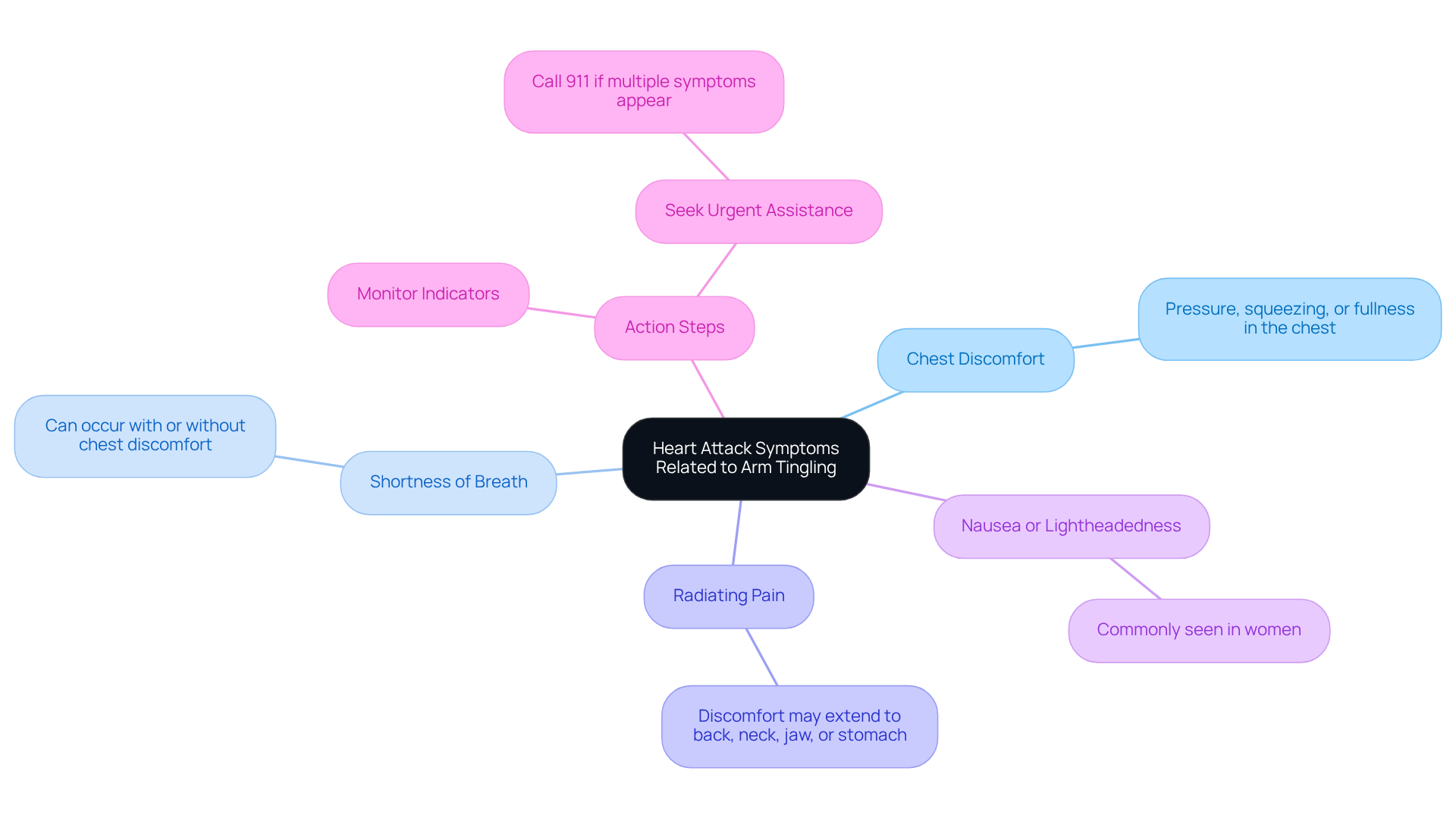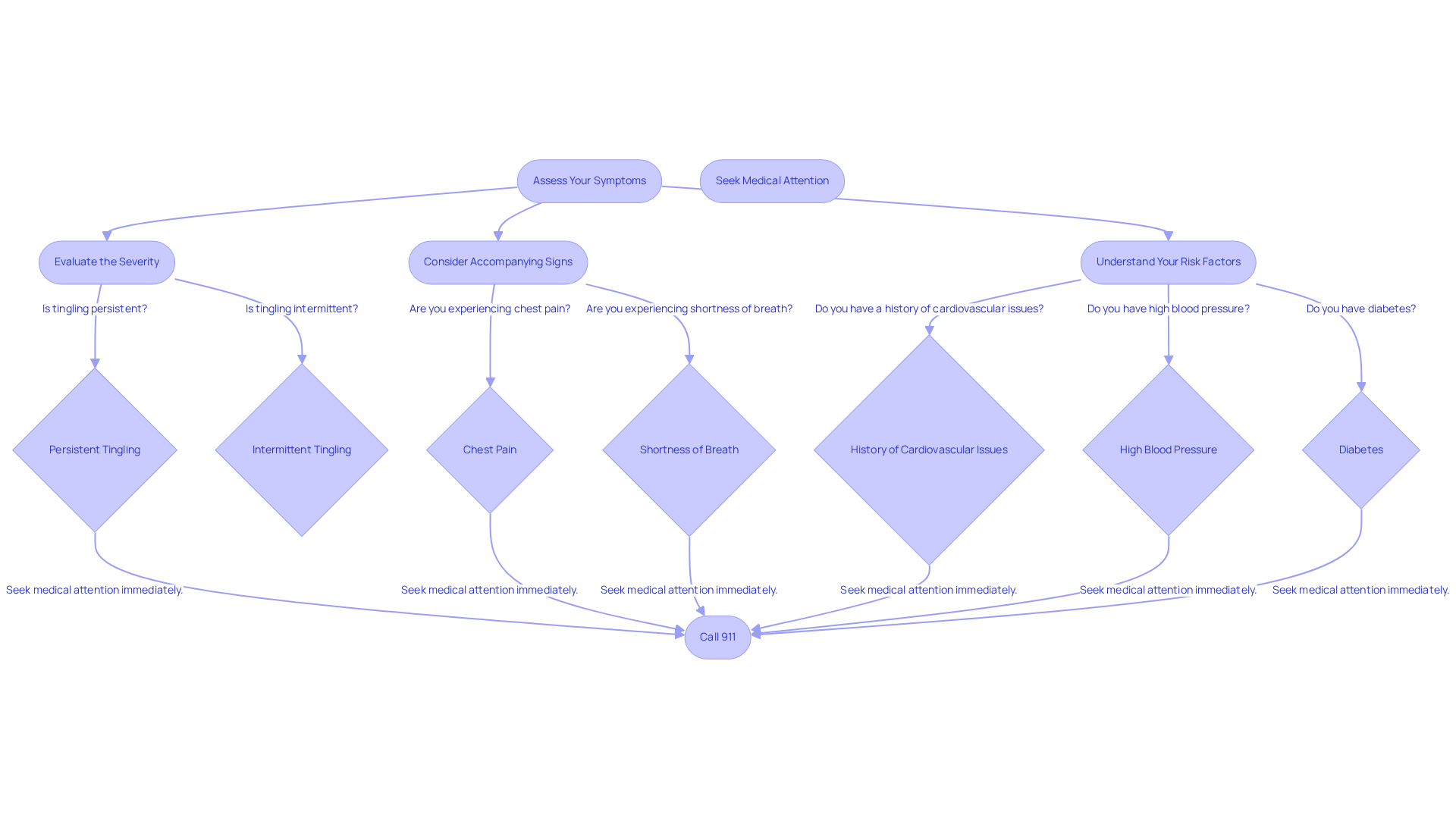


Experiencing tingling in your right arm can be a critical warning sign of a heart attack, particularly when it accompanies symptoms like chest pain and shortness of breath. This combination indicates the urgent need for medical attention. It’s essential to recognize this symptom, especially for those who may be at higher risk.
In addition to this, understanding the importance of timely intervention can significantly improve outcomes for individuals facing acute coronary syndrome. If you or someone you know is experiencing these symptoms, please don’t hesitate to seek help. Remember, you are not alone in this; there are healthcare professionals ready to support you.
Your health and well-being are paramount, and recognizing these signs is the first step toward ensuring a healthier future.
Experiencing tingling in the right arm can often be an overlooked symptom, yet it may signal a heart attack, especially when accompanied by other warning signs. This article explores the vital link between this sensation and cardiovascular events, and it emphasizes the essential steps you can take to recognize these symptoms and seek timely medical assistance. Alarmingly, many individuals do not associate arm discomfort with heart issues. This raises an important question: how can we differentiate between benign sensations and urgent health warnings? Understanding this connection could truly be the key to saving lives.
As we navigate this topic together, it’s crucial to remember that you are not alone in your concerns. Many people experience uncertainty when it comes to their health, and that’s completely natural. By shedding light on these symptoms, we aim to empower you with knowledge and support. So, let’s take a closer look at how you can recognize these signs and why it matters. Your health is important, and being informed is the first step towards taking action.
Right arm tingling can often be overlooked, yet it is a crucial warning sign of a heart attack, especially when accompanied by other symptoms. This sensation may arise from reduced blood circulation to the heart due to arterial blockages. While discomfort in the left arm is more frequently associated with heart issues, it's important not to dismiss right arm tingling, particularly for those with risk factors such as advanced age, hypertension, or diabetes.
At Amavita Heart and Vascular Health®, we understand the concerns you may have regarding your heart health. We emphasize the importance of thorough cardiac evaluations, which include advanced risk assessment tools and personalized interventions tailored to your unique needs. Did you know that studies indicate 67.3% of participants recognize arm pain or numbness as a sign of a cardiac event? This statistic underscores the necessity for heightened awareness.
Symptoms such as chest pain, shortness of breath, and nausea often accompany a right arm tingling heart attack, highlighting the urgency for immediate medical attention. Understanding this connection is vital for timely intervention, as early diagnosis can significantly improve outcomes for those experiencing acute coronary syndrome (ACS). Cardiologists stress that recognizing unusual signs, including a right arm tingling heart attack, is essential for accurate diagnosis and effective treatment, especially in at-risk groups.
Therefore, if you experience a right arm tingling heart attack along with other signs of a cardiac event, please stay alert and seek urgent medical attention. Additionally, our CardioElite™ program offers comprehensive cardiovascular management, integrating advanced diagnostic tools, lifestyle modifications, and personalized care. We are here to enhance your outcomes and reduce readmissions, ensuring you feel supported every step of the way.

Recognizing the signs associated with right arm tingling heart attack is essential for assessing the risk of a cardiac event, particularly for high-risk individuals such as those with diabetes, hypertension, or a family history of cardiovascular issues. Key symptoms to be aware of include:
It's crucial to acknowledge that every 40 seconds, an individual in the United States suffers a heart attack. This statistic underscores the importance of identifying these signs. At Amavita Heart and Vascular Health, Dr. Martinez-Clark's expertise ensures that sophisticated tests are integrated into your comprehensive care plan, providing advanced imaging capabilities that go beyond standard practices.
Action Steps:
Furthermore, recognizing that signs may differ between males and females can improve awareness and reaction to possible cardiac events. A case study on the significance of identifying heart attack signals emphasizes how prompt intervention can save lives.

Evaluating your health indicators is crucial when considering emergency assistance. Here’s how to assess your condition thoughtfully:
Emergency Signs:
Recognizing these indicators is especially important for older patients, who might notice mild symptoms like fatigue or indigestion. It’s alarming to know that about fifty percent of individuals who suffer a fatal cardiovascular event had no prior warning signs. This underscores the importance of staying alert to your body’s signals. Medical professionals consistently emphasize that if you’re uncertain about your symptoms, it’s always better to seek evaluation right away. Ignoring unusual sensations can lead to missed opportunities for timely treatment, which is vital in emergencies. Remember, you are not alone in this, and reaching out for support is a strong and courageous step.

Implementing preventive strategies can significantly lower the risk of cardiac events. Let's explore some key steps together:
Adopt a Heart-Healthy Diet: It's important to emphasize a diet rich in fruits, vegetables, whole grains, and lean proteins while minimizing saturated fats and sugars. This approach not only promotes cardiovascular health but also supports weight management and overall well-being. Amavita's Optimal Program includes nutritional advice designed to foster cardiovascular health, ensuring you feel your best.
Stay Physically Active: Aim for at least 150 minutes of moderate aerobic activity each week. Consistent exercise is essential for preserving cardiovascular wellness and can greatly reduce the likelihood of cardiac illness. Regular consultations as part of Amavita's services can help tailor an exercise plan suited to your individual needs, making it easier to stay active.
Manage Stress: Engaging in relaxation techniques such as yoga or meditation can help lower stress levels. Persistent stress can adversely affect cardiovascular well-being, making stress management a crucial element of a healthy lifestyle. Amavita offers comprehensive support to help you manage stress effectively, allowing you to find peace of mind.
Regular Health Check-ups: It's vital to monitor blood pressure, cholesterol levels, and diabetes regularly. The Optimal Program includes quarterly consultations and comprehensive biomarker panels, along with cardiac screening, to ensure proactive health monitoring. Staying informed about your health is a powerful step towards prevention.
Avoid Tobacco: Stopping smoking is one of the most effective methods to enhance cardiovascular health. Amavita's programs provide resources and support for those looking to quit, helping you take this important step towards a healthier life.
By integrating these strategies with Amavita's advanced heart health monitoring and support services, you can enhance your cardiovascular care and reduce the risk of serious health issues. Remember, you are not alone on this journey; we are here to support you every step of the way.

Right arm tingling should never be dismissed as a trivial symptom; it can serve as a critical warning sign of a heart attack. This connection underscores the importance of awareness, especially for individuals with risk factors such as hypertension, diabetes, or advanced age. Recognizing this symptom—particularly when accompanied by other indicators like chest pain or shortness of breath—is essential for timely medical intervention.
The article highlights key symptoms associated with heart attacks, emphasizing the need for vigilance in identifying these signs.
These are crucial indicators that should prompt immediate action. Alarmingly, heart attacks occur every 40 seconds, reinforcing the urgency of understanding and responding to these symptoms. By monitoring health indicators and knowing when to seek emergency care, individuals can significantly improve their chances of survival and recovery.
Ultimately, proactive measures such as adopting a heart-healthy diet, engaging in regular physical activity, managing stress, and avoiding tobacco can play a pivotal role in preventing heart attacks. Integrating these strategies into daily life while remaining vigilant about potential symptoms empowers individuals to take charge of their heart health. Awareness and education are vital; therefore, sharing this knowledge and encouraging others to recognize the signs of a heart attack fosters a healthier, more informed community. Remember, you are not alone in this journey—support is always available.
What does right arm tingling indicate in relation to heart health?
Right arm tingling can be a crucial warning sign of a heart attack, especially when accompanied by other symptoms, as it may arise from reduced blood circulation to the heart due to arterial blockages.
Is right arm tingling more serious than left arm discomfort?
While discomfort in the left arm is more commonly associated with heart issues, right arm tingling should not be dismissed, particularly for individuals with risk factors such as advanced age, hypertension, or diabetes.
What percentage of people recognize arm pain or numbness as a sign of a cardiac event?
Studies indicate that 67.3% of participants recognize arm pain or numbness as a sign of a cardiac event, highlighting the importance of awareness regarding this symptom.
What other symptoms often accompany right arm tingling during a heart attack?
Symptoms such as chest pain, shortness of breath, and nausea often accompany right arm tingling during a heart attack, indicating the urgency for immediate medical attention.
Why is it important to understand the connection between right arm tingling and heart attacks?
Understanding this connection is vital for timely intervention, as early diagnosis can significantly improve outcomes for those experiencing acute coronary syndrome (ACS).
What should one do if they experience right arm tingling along with other cardiac symptoms?
If you experience right arm tingling along with other signs of a cardiac event, it is important to stay alert and seek urgent medical attention.
What services does Amavita Heart and Vascular Health® provide?
Amavita Heart and Vascular Health® offers comprehensive cardiovascular management through the CardioElite™ program, which includes advanced diagnostic tools, lifestyle modifications, and personalized care to enhance outcomes and reduce readmissions.